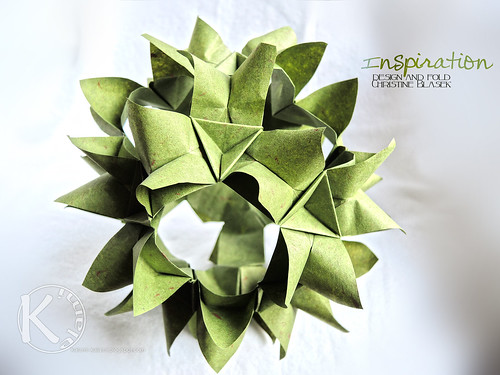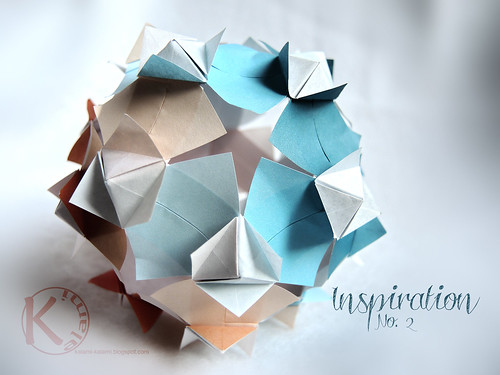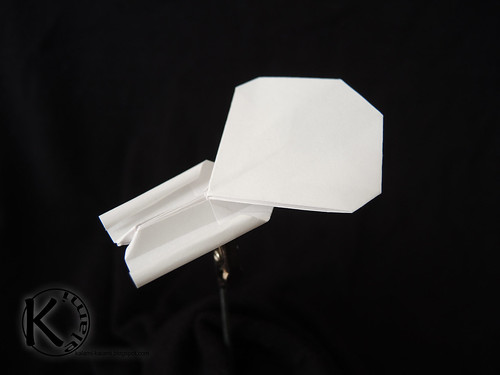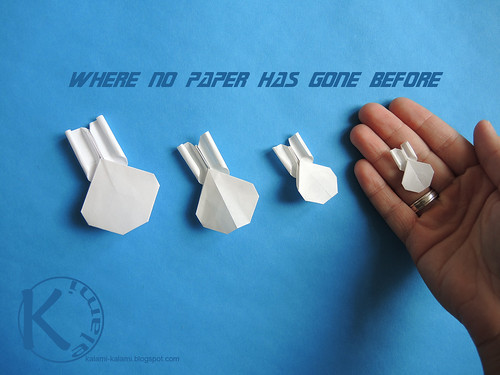Während der Origami Convention, dieses Jahr in Erkner, begegnete mir solch eine Faltung. Versteckt ist sie in einer niedlichen kleinen Meise, die ich im Workshop von Sébastien Limet lernte. Bereits als Sébastien sagte, wir dürfen bei dem Modell nicht alle Falten durchziehen, wurde ich hellhörig. Das bedeutet, man faltet bis zu einem bestimmten Punkt und der übrige Teil des Papiers wird nur gebogen. Bei der Meise entsteht auf diese Art der obere Teil des Kopfes.
 |
| Das Original ist hier |
Hat man eine solche Faltsequenz, beginnt der schwierige Teil. Man muss das übrige Papier dazu verwenden, eine Tasche und Lasche zu falten, um die einzelnen Module miteinander zu verbinden. Weil ich die Faltung nicht vergessen wollte, habe ich schon während des Workshops angefangen, daran herumzutüfteln. Manchmal, ganz selten, greift aber einfach eins ins andere und am Ende unseres Lehrgangs hatte ich nicht nur das fertige Vögelchen in der Hand, sondern auch drei miteinander verbundene Module. Den Rest des Tages faltete ich dann fleißig Module und kurz vor Mitternacht war der Prototyp dann tatsächlich schon fertig.
Ich der darauffolgenden Woche habe ich noch eine weitere Variante des Modells gefaltet. Danach war erstmal Ruhe, aber ich kann schon so viel verraten, ich bin wieder dran und habe eine weitere Idee, an der ich gerade falte.
 |
| das Papier ist von der "Eifeltor Mühle" |
When I'm designing modular Origami, sometimes it is enough to have a short folding sequence, that I'd like to include in a globe. Especially round shapes gain my interest. With these shapes you can imitate natural and floral structures much better.
During this years Origami Convention in Erkner, I found such a perfect fold. Hidden in a cute little tit, that I learned in a workshop by Sébastien Limet. Already at the beginning, when Sébastien said, some of the folds needn't to be folded through, he got my attention. This means, you fold the paper just to a special point and the rest of it is just bent. For the tit it is the upper part of the head.
 |
| das Papier ist von "Valley Folder" |
Have you found such a folding sequence, the hard part is about to begin. You have to use the rest of the paper to form a pocket and a flap, to join the units with each other. Because I didn't want to forget the folds, I already started to experiment on it during the workshop. Sometimes, really seldom, one leads to the other and at the End of the lesson I was not only holding a little bird in my hand, but also three connected units.The rest of the day I folded modules and just before midnight the prototype was finished.
In the upcoming week I also folded a variation of the model. After this, it went quiet about it, but I can tell you, I had a new idea and these days, I'm working on it.



